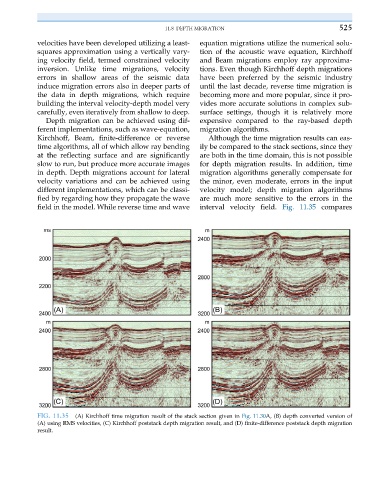Page 534 - Acquisition and Processing of Marine Seismic Data
P. 534
11.8 DEPTH MIGRATION 525
velocities have been developed utilizing a least- equation migrations utilize the numerical solu-
squares approximation using a vertically vary- tion of the acoustic wave equation, Kirchhoff
ing velocity field, termed constrained velocity and Beam migrations employ ray approxima-
inversion. Unlike time migrations, velocity tions. Even though Kirchhoff depth migrations
errors in shallow areas of the seismic data have been preferred by the seismic industry
induce migration errors also in deeper parts of until the last decade, reverse time migration is
the data in depth migrations, which require becoming more and more popular, since it pro-
building the interval velocity-depth model very vides more accurate solutions in complex sub-
carefully, even iteratively from shallow to deep. surface settings, though it is relatively more
Depth migration can be achieved using dif- expensive compared to the ray-based depth
ferent implementations, such as wave-equation, migration algorithms.
Kirchhoff, Beam, finite-difference or reverse Although the time migration results can eas-
time algorithms, all of which allow ray bending ily be compared to the stack sections, since they
at the reflecting surface and are significantly are both in the time domain, this is not possible
slow to run, but produce more accurate images for depth migration results. In addition, time
in depth. Depth migrations account for lateral migration algorithms generally compensate for
velocity variations and can be achieved using the minor, even moderate, errors in the input
different implementations, which can be classi- velocity model; depth migration algorithms
fied by regarding how they propagate the wave are much more sensitive to the errors in the
field in the model. While reverse time and wave interval velocity field. Fig. 11.35 compares
FIG. 11.35 (A) Kirchhoff time migration result of the stack section given in Fig. 11.30A, (B) depth converted version of
(A) using RMS velocities, (C) Kirchhoff poststack depth migration result, and (D) finite-difference poststack depth migration
result.

